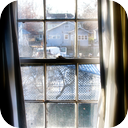(short preview of full seamless looping track)
Rattling Window
This product is not available in the selected currency.
In Stock
Backordered
Out of Stock
Description
The white fields of snow are whipped into little crystal clouds that blow along the unbroken plains and make a crackling sound as they slide into the sides of houses, slipping through cracks and shaking old windows until they can breach the seals and send a small bit of frost floating into each warm house. You notice a snowflake floating in your living room, seeming to defy the dry heat from the fireplace, and you touch it moments before it melts away forever. Window is first recorded in the early 13th century, and originally referred to an unglazed hole in a roof. Window replaced the Old English ‘eagþyrl’, which literally means ‘eye-hole,’ and ‘eagduru’ ‘eye-door’. Many Germanic languages however adopted the Latin word ‘fenestra’ to describe a window with glass, such as standard Swedish ‘fönster’, or German ‘Fenster’. The use of window in English is probably due to the Scandinavian influence on the English language by means of loanwords during the Viking Age. In English the word fenester was used as a parallel until the mid-18th century and fenestration is still used to describe the arrangement of windows within a facade. Primitive windows were just holes in a wall. Later, windows were covered with animal hide, cloth, or wood. Shutters that could be opened and closed came next. Over time, windows were built that both protected the inhabitants from the elements and transmitted light: mullioned glass windows, which joined multiple small pieces of glass with leading, paper windows, flattened pieces of translucent animal horn, and plates of thinly sliced marble. The Romans were the first to use glass for windows. In Alexandria ca. 100 CE, cast glass windows, albeit with poor optical properties, began to appear.
Opps
Sorry, it looks like some products are not available in selected quantity.



